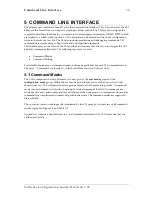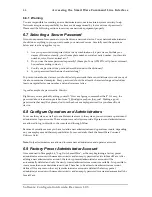
Configuration Concepts
31
entities. In SmartWare however, an interface is a logical construct that provides higher-layer protocol
and service information, such as layer 3 addressing. Interfaces are configured as part of a context,
and are independent of physical ports and circuits. The decoupling of the interface from the physical
layer entities enables many of the advanced features offered by SmartWare.
In order for the higher-layer protocols to become active, you must associate an interface with a
physical port or circuit. This association is referred to as a
binding
in SmartWare. Refer to the
“Bindings” section later in this chapter for more information. In Figure 4-1, the IP context shows
three interfaces and the CS context shows four interfaces. These interfaces are configured within their
contexts. The bindings shown in the figure are not present when the interfaces are configured; they
are configured later.
4.3.2 Ports and Circuits
Ports
and
circuits
in SmartWare represent the physical connectors and channels on the SmartNode
hardware. The configuration of a port or circuit includes parameters for the physical and data link
layer such as line clocking, line code, framing and encapsulation formats or media access control.
Before any higher-layer user data can flow through a physical port or circuit, you must associate that
port or circuit with an interface on a context. This association is referred to as a
binding
. Refer to the
section below for an introduction to the binding concept.
Examples of SmartNode ports are: 10bT Ethernet, Serial ISDN BRI, and ISDN PRI. Ports are
numbered according to the SmartNode port numbering scheme. The port name corresponds to the
label (or abbreviation) printed on the hardware.
Example:
Ethernet 0/1, Serial 0/0, BRI 3/2
Some ports may contain multiple
circuits.
For example serial ports can contain one or more Frame
Relay Permanent Virtual Circuits (PVC). If a port has one or more circuits configured, the individual
circuits
are bound to
interfaces
on a context. The port itself may not be bound in that case.
Example:
frame-relay pvc 112.
Figure 4-1 shows eight ports. Three ports are bound directly to an IP interface, one port has a single
circuit configured, which is bound to the IP context. Four ISDN ports are bound to CS interfaces.
4.3.3 Bindings
Bindings form the association between circuits or ports and the interfaces configured on a context.
No user data can flow on a circuit or Ethernet port until some higher-layer service is configured and
associated with it.
In the case of IP interfaces, bindings are configured statically in the port or circuit configuration. The
binding is created bottom-up, that is from the port to the interface.
In the case of CS interfaces, bindings are configured in the interface configuration. The binding is
created top-down, that is from the interface to the port. CS interfaces can bind one ore more ISDN or
PSTN ports. If more than one port is bound, the CS interface is responsible for performing channel
hunting on all bound ports. This creates a channel
hunt group
.
Figure 4-1 shows bindings from ports to IP interfaces and from CS interfaces to ISDN ports.
Software Configuration Guide, Revision 1.03
















































